
* During the Vietnam War, the US Navy acquired a strike aircraft, the LTV "A-7", which would provide decades of excellent service to the US Navy and the US Air Force. The A-7 lingered in service into the 21st century with several foreign air arms. This document provides a history and description of the A-7. A list of illustration credits is included at the end.
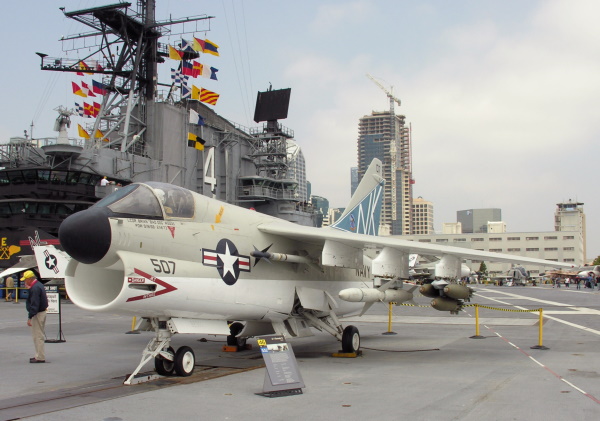
* In the early 1960s, the US Navy was casting about for a new strike aircraft to replace the Douglas A-4 (A4D) Skyhawk ("Scooter"), the replacement to offer more payload and more range. Initial studies focused on a supersonic aircraft, but it was gradually realized that supersonic performance was problematic for a low-altitude attack aircraft burdened down with external stores. A requirement for a subsonic "VA(L)" -- light attack aircraft -- was issued in the spring of 1963, specifying a single-seat aircraft powered by a Pratt & Whitney (P&W) TF30 bypass jet engine, the aircraft being armed with twin 20-millimeter cannon and carrying a maximum warload of 5,535 kilograms (12,200 pounds) over a combat radius of 1,110 kilometers (690 miles / 600 NMI). It would have radar and a limited all-weather capability.
The Navy prejudice was towards a TF30-powered Skyhawk, the "A4D-6", essentially a Scooter on steroids, but other aviation firms lobbied for a competition, which was duly set up. Along with Douglas, three other firms came up with proposals, including Grumman, North American, and Vought -- or more precisely "Ling-Temco-Vought (LTV)" as the company had become known after mergers in 1961. The Grumman concept, the "G-128-12", was a single-seat version of the company's A-6 Intruder, retaining the twin P&W J52 turbojets of the A-6 instead of using the TF30; the North American concept, the "NA-295", was based on the company's FJ-4 Fury, itself a beefed-up derivative of the company's classic F-86 Sabre, with the NA-295 featuring a TF30 engine, a radome in the lower lip of the air intake, and bristling with underwing stores.
The LTV submission, the "V-463", had started life as an attack derivative of the firm's F-8 Crusader fighter, but though LTV pushed the V-463's "commonality" with the F-8, as the development proceeded the commonality decayed. That tends to be what happens when an aircraft design is extensively modified for a role for which it was not originally supposed to perform -- but the Navy was still impressed, awarding the company a contract on 19 March 1964 for three prototypes of the "A-7" strike fighter.
The first of the three "A-7A" prototypes -- they were sometimes referred to with the designation of "YA-7A", but they weren't given a formal prototype designation -- performed its initial flight on 27 September 1965, four weeks ahead of schedule, with LTV test pilot John Konrad at the controls. Initial delivery to the Navy of production A-7As was on 14 October 1966, with the type reaching formal service on 1 February 1967 with Navy Squadron VA-147. It was in combat over Vietnam by the end of the year. Officially speaking, the A-7A was named the "Corsair II" after the famous Vought piston fighter of WWII -- actually, the A-7 was the "Corsair III", Vought having informally called the prewar O2U scout plane the "Corsair" -- but the A-7 seems to have been rarely, if ever, called that in practice. It was generally known as the "SLUF", for "Short Little Ugly Fella", or something less polite.
* The A-7A looked much like a Crusader with a shortened fuselage, and also at least initially featured the same weapons as the F-8, consisting of two Colt Mark 12 20-millimeter cannon, one on either side of the engine intake and with 250 rounds per gun. The Mark 12 was a derivative of the British Hispano 404 cannon. As noted, however, the resemblance between the F-8 and the A-7 was somewhat superficial. The F-8 had a tilt-up "variable incidence" wing to help carrier landings and had an afterburning Pratt & Whitney (P&W) J57 turbojet engine. The A-7A had a fixed wing that was thicker to provide greater fuel storage, though like the Crusader the wing had a "dogtooth" configuration, with the wingtips hydraulically folding straight up. Instead of the P&W J57 turbojet of the Crusader, the A-7 had a nonafterburning P&W TF30-P-6 bypass jet with 50.47 kN (5,150 kgp / 11,350 lbf) thrust.
The SLUF was of conventional construction, though it featured armor plating around the cockpit and vital aircraft systems to improve survivability. The armor was originally steel and aluminum plate, but later versions of the A-7 would feature lighter boron-carbide armor. The SLUF also featured redundant hydraulic systems to ensure that the aircraft could get back home after suffering battle damage. It was designed to be easy to maintain, with 50% of the aircraft's skin area covered with access panels, mostly at a height where ladders or service stands weren't needed.
The dogtooth wing featured full-span leading-edge flaps for short take-off performance, with a large slotted flap on the inner section of each trailing edge of the wing, and an aileron on the outer section. A spoiler was fitted just forward of each flap. The flap system provided good low-speed landing performance, and was why LTV had been able to get rid of the Crusader's variable-incidence wing scheme. The tailplanes were all-moving, and there was a large airbrake on the belly, behind the cockpit. Incidentally, although the rear edge of the rudder was swept, the tailfin trailing edge was straight up above the rudder; that was done to ease carrier hangar storage.
The A-7A had tricycle landing gear, with two wheels on the heavily shock-absorbed nosewheel gear and one wheel on each main gear assembly. The nosewheel assembly had a catapult attachment point, with the assembly retracting backward. The main gear retracted forward into the fuselage. A stinger-type arresting hook was fitted under the tail.
Three stores pylons were fitted under each wing, plus a stub "cheek" pylon on each side of the fuselage behind the cockpit. It is unclear if all three pylons on each wing were "wet" to permit carriage of external fuel tanks, but pictures of the A-7 do show it carrying external tanks on the innermost or outermost pylons. The usual tank had a capacity of 1,135 liters (300 US gallons). It is unclear if any other tanks were ever carried. The wing pylons all had built-in loading hoists.
The cheek pylons were another idea borrowed from the Crusader, and were normally used to carry AIM-9 Sidewinder air-to-air missiles (AAM) for self-defense. The Crusader also carried Zuni 12.7-centimeter (5-inch) rocket packs on the cheek pylons and it seems likely the SLUF could carry the same weapon there, though apparently it rarely if ever did. In any case, the SLUF could haul a total of 6,800 kilograms (15,000 pounds) of stores; it would ultimately be qualified for almost every munition a Navy aircraft could carry, including iron bombs, cluster bombs, Zuni rocket pods, naval mines, even nuclear stores.
It was also often used as a tanker with a D-704 buddy refueling pod -- essentially an external tank with a drogue refueling unit in the rear driven by a spinner in the nose. Tanker-fitted SLUFs were sometimes referred to with the designation of "KA-7", though that was only a semi-official label; they had no real differences from stock A-7s. In practice, warloads were rarely near the aircraft's load limit; a heavy warload might be 12 Mark 82 225-kilogram (500-pound) bombs, or 2,720 kilograms (6,000 pounds). Particularly for the later variants of the A-7, bombing precision was very good, and there was no need to bomb the aircraft up to its full capability.
The pilot sat on a McDonnell Douglas ESCAPAC 1C2 ejection seat under a clamshell canopy that hinged open to the rear. The ejection seat had rams to allow ejection through the canopy in an emergency. The windscreen was hardened against birdstrikes, and was resistant to projectile hits. Bleed air could be blown over the windscreen to deflect rain and for de-icing. A midair refueling probe was mounted along the right side of the cockpit, with the probe pivoting outward for use. The pilot climbed into the cockpit from the left, using a built-in two-step stirrup-type pulldown ladder and two pop-open footsteps. It appears that clambering in or out of the cockpit in full flight gear using this scheme was tricky, with aircrew commenting that it was the hardest part of flying the aircraft.
Avionics kit in the A-7A included a Texas Instruments AN/APQ-11 multimode radar, the nose radome being the upper lip of the engine intake, with the radome hinging up for servicing; Doppler navigation radar; a navigation system; and a moving-map display; along with standard radios and "identification friend or foe (IFF)" transponder.
* Some sources claim that the A-7A got off to a slow start in service, though it appears that part of the problem was that aircrews simply found it ugly and off-putting, not to mention slow. There were glitches of course, with steam from aircraft carrier catapults sometimes leading to engine stalls on take-off; improved deck sealing was implemented to reduce steam emissions.
A somewhat more fundamental problem was that the A-7A was underpowered. As a result, after production of 199 (some sources say 193) A-7As, production rolled to the "A-7B", which was generally identical to the A-7A but had a more powerful TF30-P-8 engine, which provided 54.3 kN (5,534 kgp / 12,200 lbf) max thrust. Most or all of the A-7Bs were later upgraded to the still more powerful TF30-P-408 with 4,535 kN (6,080 kgp / 13,400 lbf) thrust. Sources hint that the upgrade from the TF30-P-8 to the TF30-P-408 was performed with an engine modification kit, not a complete engine replacement. A total of 196 A-7Bs was built. A two-seat version of the A-7B, designated the "A-7C", was considered but never flew. However, the designation and the two-seater concept would be back, if not together.
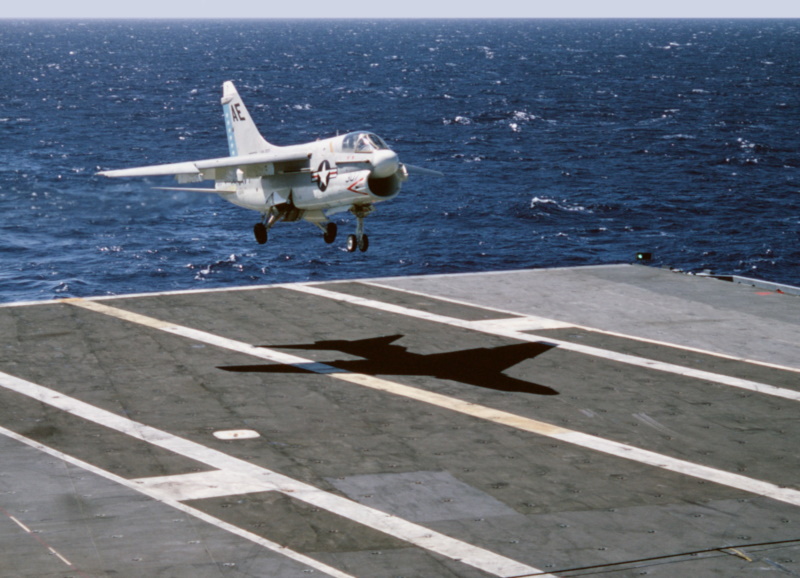
* The A-7A performed its first combat action on 4 December 1967, launched off the carrier USS RANGER to perform a strike on North Vietnam. The A-7As kept busy, in particular performing close-support strikes in the defense of Khe Sanh in early 1968. The A-7B joined the A-7A in combat in early 1969. At this time, Navy A-7s sported natty standard colors for the era: gull gray on top, white on bottom.
BACK_TO_TOP* The US Marines never acquired the A-7, having doubts it was the right fit for frontline battlefield support, and preferring to obtain the improved A-4M Skyhawk instead. However, even before the A-7 went into Navy service, the US Air Force (USAF) had decided to acquire the type as a replacement for the North American F-100 Super Sabre and the Douglas A-1 Skyraider; in fact, three USAF pilots were part of the initial deployment of the A-7A on the USS RANGER, the Air Force men becoming proficient at carrier take-offs and landings, as well as participating in strikes.
The Air Force did want a more powerful engine, settling on the Allison TF41, a license-built British Rolls-Royce nonafterburning Spey bypass jet tweaked to US specifications. The first USAF version, the "A-7D", was fitted with an Allison TF41-A-1 with 64.5 kN (6,575 kgp / 14,500 lbf) thrust, and performed its initial flight in September 1978. The TF41 provided a fair step up in power relative to the TF30; some sources hint that the TF41 was well more reliable than the TF30, which had some teething problems. The A-7D also featured a number of other major changes as per USAF requirements, including:
The Air Force was flying A-7Ds out of Thailand by October 1972, standard colors being disruptive camouflage on top -- brown and dark green -- with white on the bottom. The A-7D was initially used in the "Sandy" role, providing teeth to back up search and rescue teams trying to retrieve downed airmen. It replaced the Douglas A-1 Skyraider in this role. It was also used in the LINEBACKER and LINEBACKER II campaigns against North Vietnam late in the year.
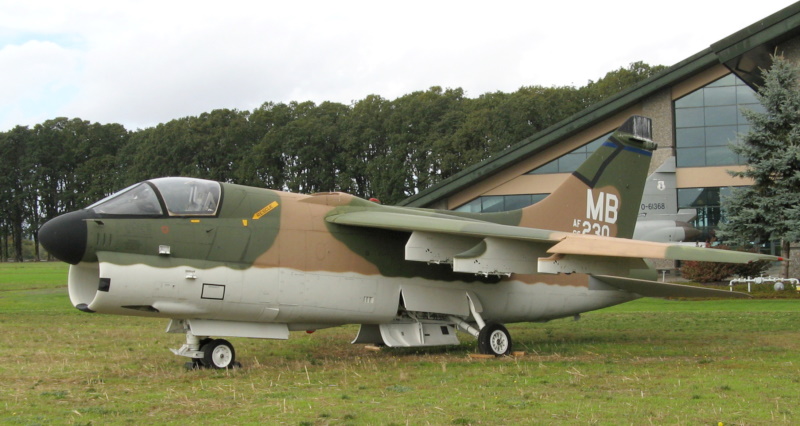
Many USAF pilots had originally been put off by the ugly little SLUF, but the type's NWDS gave them an unprecedented precision strike capability, and they had little complaint about the A-7D's, sophistication, warload, and survivability. A total of 459 A-7Ds was built in all.
* The Navy liked a number of features of the A-7D, including the TF41 engine, the Vulcan cannon, and much of the improved avionics suite. The service decided to obtain their own equivalent, to be named the "A-7E", with a slightly uprated TF41-A-2 engine with 66.7 kN (6,800 kgp / 15,000 lbf) thrust. The A-7E was to retain the refueling probe and had a somewhat different avionics fit, including Navy-specified radios and countermeasures kit.
___________________________________________________________________
LTV A-7E SLUF:
___________________________________________________________________
wingspan:
11.8 meters (38 feet 9 inches)
wingspan (folded):
7.24 meters (23 feet 9 inches)
wing area:
38.84 sq_meters (375 sq_feet)
length:
14.06 meters (46 feet 2 inches)
height:
4.9 meters (16 feet 1 inches)
empty weight:
8,990 kilograms (19,915 pounds)
max take-off weight:
19,050 kilograms (42,000 pounds)
max speed, low level:
1,125 KPH (700 MPH / 605 KT)
service ceiling:
15,545 meters (51,000 feet)
combat radius:
1,430 kilometers (890 MI / 775 NMI)
___________________________________________________________________
However, there were delays in the delivery of the TF41 engines for the A-7E, and so the Navy ordered initial production to go ahead with the TF30-PW-408 engine. 67 of these TF30-powered machines were built before production transitioned to the TF41, and to avoid confusion these early production machines were given the unused "A-7C" designation, with the A-7C going into combat service late in 1969.
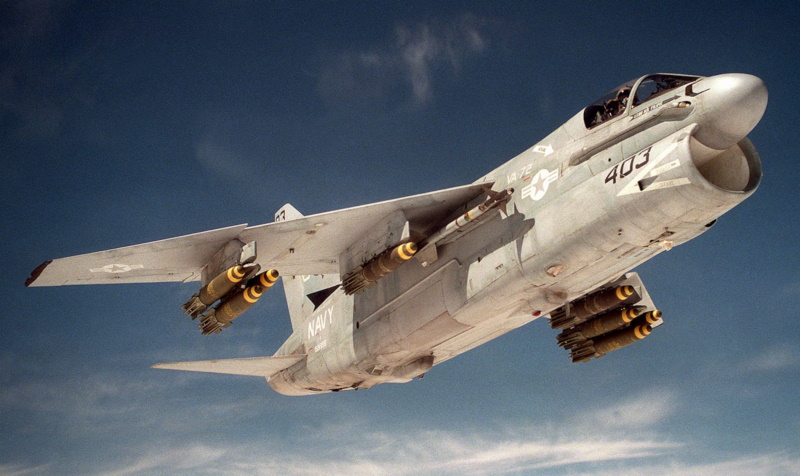
The TF41-powered A-7E was the most heavily produced version of the SLUF, with 535 built. It made its combat debut over Southeast Asia in May 1970. Aircrews were particularly impressed with the accuracy of its advanced attack systems. The A-7E quickly replaced older A-4 Skyhawks and first-generation SLUFs in the firstline strike role. It was also used in the defense suppression role, using AGM-45 Shrike or AGM-78A Standard ARM anti-radar missiles to attack radar sites.
When the air war heated back up in 1972, A-7Es helped mine Haiphong harbor, and performed numerous strikes during the LINEBACKER I and LINEBACKER II bombing campaigns.
BACK_TO_TOP* SLUFs received a number of upgrades in the post-Vietnam period. In 1977, the Air Force began to refit their A-7Ds with an "Automated Maneuvering Flaps" scheme, in which the flight control system could automatically adjust the leading-edge and trailing-edge flaps to compensate for the aircraft's tendency to "depart" (go into a spin) at high angles of attack.
At about the same time, the USAF fitted A-7Ds with a "Pave Penny" laser spot tracker module under the bottom lip of the air intake. The Pave Penny was used on the Fairchild A-10 Warthog; it allowed a pilot to zero in on a target illuminated by a laser designator beam employed by ground forces or a forward air controller. The A-7D's Pave Penny pod was slaved into the HUD to help him spot the target. Laser-guided bombs (LGBs) could then be used for a precision strike. The A-7D's AN/APQ-126 radar also received some subsystem upgrades to improve reliability. New weapons were qualified, particularly the AGM-65 Maverick ASM, which could in principle be carried on the cheek pylons, as well as the underwing pylons.
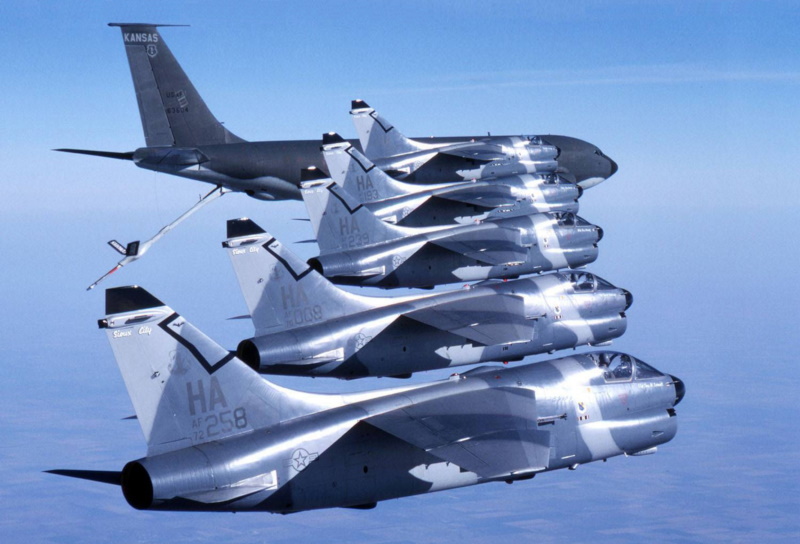
By the early 1980s, the A-7D had been largely phased out of first-line USAF service in favor of the A-10. The A-7Ds were passed on to Air National Guard (ANG) units, with the first deliveries of SLUFs to ANG squadrons in October 1975. In the postwar period, USAF A-7s retained disruptive camouflage but in wraparound paint schemes, initially green and brown overall, later multi-tone gray.
* The Navy also adopted the Automated Maneuvering Flaps scheme for their A-7Es, and fitted 200 A-7Es with an "AN/AAR-45 Forward Looking Infrared (FLIR)" pod, carried on the right inboard stores pylon and displaying thermal imagery on the pilot's HUD. The FLIR pod gave the A-7E a night / bad-weather strike capability, one pilot calling it "absolutely amazing". It was a primary component of the A-7E's "Low Altitude Night Attack (LANA)" capability, along with terrain-following radar, allowing the SLUF to perform low-altitude penetration and strike at night and in bad weather. The A-7E was qualified for new stores as well, such as:
By this time, the Navy had given up on the traditional neat gull gray / white color scheme, replacing it instead with a more practical if dingy looking "tactical paint scheme" of overall mottled gray.
The SLUF didn't see combat after the end of the US involvement in Vietnam until the fall of 1983, when it participated in Operation URGENT FURY, the invasion of the Caribbean island of Grenada. After a Leftist coup in the little island nation, US President Ronald Reagan ordered US forces to occupy the country. US Navy A-7Es flew nearly 300 sorties in support of American ground forces fighting Cuban advisers on the island. The SLUFs dropped iron bombs and Rockeye cluster bombs, and also strafed targets with their Vulcan cannon.
There were doubts afterward that URGENT FURY had been justified, and the action had been marked by considerable bumbling due to the haste in which the operation had been organized -- but it demonstrated that the US was once again willing to use its military muscle. It went over well with the American public, greatly enhancing Reagan's popularity. The defects of the operation led to a military reform movement, resulting in the bipartisan Goldwater-Nichols Act of 1986 that rearranged the military command structure to ensure better coordination between the different US armed services.
* The SLUF was in combat elsewhere at roughly the same time, and it didn't work out quite as well. Reagan had decided to order US military intervention in the civil war in Lebanon in an attempt to restore order, but the result was a disaster. On 23 October 1983, the Lebanese Islamic Hezbollah faction used a truck bomb to destroy the US Marines barracks near the Beirut airport, killing 241 Americans.
The US government decided to perform retaliatory airstrikes on the Hezbollah and their Syrian backers in Lebanon. The strike was delayed, but finally went ahead on 4 December 1983, using a mix of carrier assets. It was poorly planned and ran into tough Syrian air defenses. One A-7E was shot down, the pilot being recovered safely, and another A-7E was so badly damaged that it had to be written off after landing. A Grumman A-6E Intruder was shot down, one of the crewman being killed and the other made a captive of the Syrians for a month. Not only had the air strike been an ineffectual embarrassment, the whole US effort in Lebanon, not well thought-out to begin with, had come completely unraveled. The US soon cut their losses and withdrew.
* However, the Reagan administration was more determined in their dealings with the eccentric Libyan dictator Colonel Mohamar Qaddafi. Qaddafi took an anti-American line and supported international revolutionary movements; Reagan saw him as a threat to peace and sent in the US Mediterranean Fleet to challenge Qaddafi's declaration of a "zone of death" well off Libyan shores. Confrontations followed, leading to strikes on 24 and 25 March 1986 by US Navy aircraft, including A-7Es, with Libyan air-defense sites bombed and a number of small Libyan Navy vessels sunk. A-7E actions included launch of HARM missiles to shut down Libyan radars, that being the Navy's first use of the weapon, which proved very effective.
That was just a warmup. On 5 April 1986, a bomb blew up in a Berlin disco, killing two, including one American serviceman, and injuring over 200 others. US intelligence linked the bombing to the Libyans, and in response the US organized a major air raid on Libya on the night of 14:15 April 1986. The action, named Operation EL DORADO CANYON, involved both US Air Force and US Navy assets performing strikes on a wide range of targets, with A-7Es flying as part of the naval contingent. The strikes were on target; although Libyans rallied behind Qaddafi in response, Libyan involvement in terrorist activities seemed to fade out after that time.
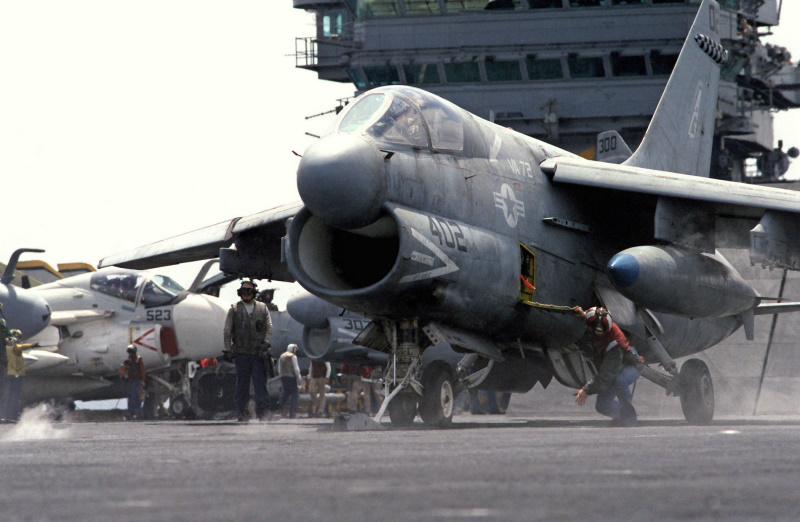
* The A-7 also participated in the "Tanker War" in the Persian Gulf in 1988. During the Iran-Iraq War, tanker traffic navigating through the Persian Gulf had to endure attacks by both sides, and in 1987 and 1988 US Navy vessels were operating in the Gulf in an attempt to maintain order. As could be expected, they took hits on a number of occasions. On 14 April 1988, the US Navy frigate SAMUEL B. ROBERTS struck an Iranian mine, and on 18 April the Navy performed air and missile strikes under Operation PRAYING MANTIS on Iranian oil platforms and naval assets in retaliation. A-7Es participated in the strikes, most notably sinking the Iranian frigate SAHAND, pounding it with iron bombs and Walleyes, as well as destroying a number of Iranian attack boats with Rockeye cluster bombs.
Air Force A-7Ds did not see combat action in the post-Vietnam timeframe until 1989 -- and even then it was minimal, with the Ohio Air National Guard providing air cover for the US occupation of Panama in that year.
* Although the SLUF was being drawn down rapidly in US Navy service by the late 1980s and early 1990s, being replaced by the McDonnell Douglas F/A-18 Hornet, there were still two A-7E squadrons in service during the Gulf War in 1991. They participated in the conflict, beginning by firing HARM antiradar missiles on the first day of the air war, 17 January 1991, to disable Iraqi radars. They followed up these actions over the following weeks by attacks with Walleye glide bombs, the new AGM-84E SLAM cruise missile, as well as dumb bombs and cluster munitions. No SLUFs were lost in action, but one was damaged beyond repair in a launch accident.
The last full US Navy and Navy Reserve SLUF squadrons were disbanded in the spring of that same year, 1991. Some two-seaters remained in Navy service until 1994 in the weapons test role. US ANG SLUFs were finally retired in 1993, having been replaced by the General Dynamics F-16 in the attack role. As discussed below, some of the retired SLUFs were passed on to foreign users.
BACK_TO_TOP* The idea of a two-seat SLUF trainer was revived after Vietnam, with the Navy performing a conversion of the first TF41-powered A-7E in 1972. The machine was given an 86-centimeter (34-inch) fuselage stretch to accommodate a second seat, and fitted with a canopy that hinged open to the right. The rear seat was raised to give the flight instructor in the back seat a better forward view. It performed its initial flight on 19 August 1972, with test pilot John Konrad once more at the controls.
This aircraft was initially referred to as the "TA-7H", but then the "H" suffix was applied to SLUFs sold to Greece (see below), and it was then redesignated "TA-7E". The machine was demonstrated for the next few years, and then LTV was awarded a contract to modify 60 TF30-P-408-powered SLUFs, including 24 A-7Bs and 36 A-7Cs, to a similar specification with the designation "TA-7C".
The first TA-7C conversion performed its initial flight on 17 December 1976, with deliveries to the Navy from January 1977. In 1982, eight of the TA-7Cs were modified to act as "electronic aggressor" machines, carrying electronic gear to simulate Soviet electronic attack platforms. The electronic aggressor machines were given the designation "EA-7L", with the first was delivered to the Navy in 1983. In 1984, LTV received a contract to update the 41 surviving TA-7Cs and the eight EA-7Ls to A-7E standard, fitted with the TF41-A-402 engine, maneuvering flaps, and new Stencel ejection seats.
The Air Force also liked the idea of a tandem-seat SLUF, and in 1979 gave LTV a contract to update an A-7D to a stretched two-seat configuration similar to that of the Navy TA-7C. The Air Force two-seater was originally designated the "TA-7D" and then the "A-7K". The A-7K remained fully combat-capable. The prototype effort led to the purchase of 30 new-build A-7Ks for the ANG, with deliveries from 1981 through 1984.
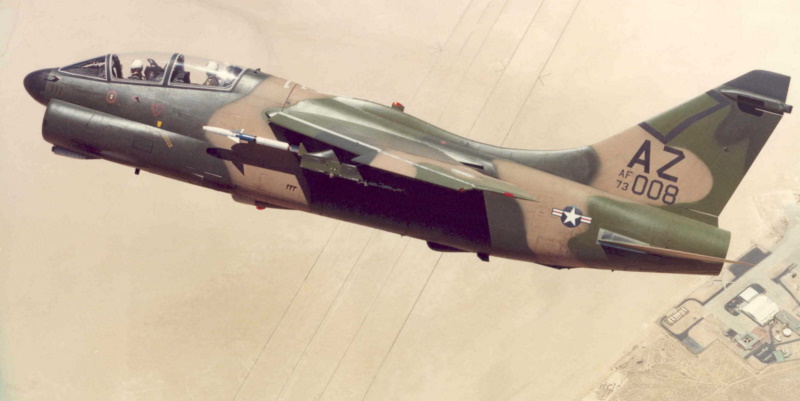
* In 1985, the USAF requested proposals for a "Close Air Support / Battlefield Area Interdiction (CAS/BAI)" aircraft as a potential replacement for the Fairchild A-10 Warthog. LTV replied with a proposal for an improved, supersonic SLUF, and in 1987 the USAF awarded the company a contract to update two A-7Ds to this specification.
The new "Super SLUF" was originally known as the "A-7D Plus" and then the "YA-7F". The two machines were fitted with a P&W F100-PW-200 afterburning bypass jet with 71.2 kN (7,255 kgp / 16,000 lbf) afterburning thrust, which required a fuselage stretch of 1.2 meters (4 feet). The modified machines were also fitted with a larger tail assembly, leading-edge wingroot extensions, and in production would have advanced cockpit controls and avionics.
Since the SLUF looked like a stubby F-8 in the first place, stretching it back out again make it look something like a more brutish version of a Crusader. The first YA-7F performed its initial flight on 29 November 1989, with the second following in the spring of 1990. Plans were considered to upgrade Navy and Air Force SLUFs to this spec, but changes in requirements with the end of the Cold War killed the program.
Sources also mention a proposed "KA-7F" dedicated tanker version of the SLUF. It is unclear if it featured the F100 engine, but in any case it wasn't built. There was also talk of a photo-reconnaissance SLUF, but it seems that the only time an A-7 carried a reconnaissance pod was in trials. In addition, LTV proposed an "A-7X" that would have a GE F110 engine, comparable to the P&W F100, or two GE F404 engines as used on the McDonnell Douglas F/A-18 Hornet.
BACK_TO_TOP* The SLUF was exported in modest numbers to Greece, Portugal, and Thailand. An "A-7G" was offered to Switzerland in 1972, but the Swiss chose the Northrop F-5E Tiger II for their requirement instead, and the Carter Administration sank a plan to transfer 100 used SLUFs to Pakistan.
The Greeks were the first foreign users to actually obtain the type, and were the only foreign users to obtain new-production machines. The Greek SLUF was designated the "A-7H", where "H" stood for "Hellenic", and was very similar to the A-7D. The first A-7H performed its initial flight on 6 May 1975. 60 were provided to the Hellenic Air Force, along with five "TA-7H" two-seaters. They replaced the Republic F-84 Thunderstreak in Greek service.
The Greeks flew the A-7 in the attack role, and also flew them in a secondary air defense role with Sidewinder AAMs. They liked the SLUF very much, and obtained 36 surplus A-7Es and TA-7Cs in the 1990s. They were finally retired in 2014.
* In the early 1980s, the Portuguese Air Force obtained a number of updated A-7As under the designation "A-7P". These machines were fitted with the TF30-P-408 engine and the avionics suite of the A-7A, though they retained the twin Mark 12 20 millimeter cannon. 20 A-7Ps, along with a leased A-7C, were provided in 1981. They were followed in 1984 by 24 A-7Ps, and then six two-seat "TA-7Ps" in 1985. A number of A-7A spares hulks were also provided.
The A-7Ps served in the air defense role for a time, carrying Sidewinder AAMs, but as that role was taken up by the General Dynamics F-16 Viper they were able to focus on their natural strike role. Portuguese A-7Ps were armed with iron bombs and the Maverick ASM in the attack role. They were also fitted with a defensive countermeasures suite, with an RWR and chaff-flare dispensers, and could carry AN/ALQ-131 jammer pods. The last were retired in 1999.
* A total of 20 surplus A-7Es and TA-7Cs, including two A-7E spares hulks, was sold to the Thai Navy in 1995. Although the Thai Navy has a carrier, it was designed for use with helicopters and Harrier jump-jets, and features a "ski-jump" bow for Harrier take-offs. It is unclear if the SLUF could take off or land on such a vessel under any circumstances, but in any case the Thai SLUFs were strictly land-based. At last notice, they were in standby storage.
BACK_TO_TOP* A total of 1,355 A-7s was built in all. Variants included:
* I had a few encounters with SLUFs when I was stationed in the Army at Fort Hood, Texas, in 1973:1974. Once my company was forming up in the brush for some purpose or other when an A-7D flashed over our heads in a quick but intimidating roar. On other field exercises I recall Cessna Skymaster spotter planes orbiting over the training area, calling in "strikes" by SLUFs that pounced on their targets, and then arced up into the sky. No doubt an umpire showed up afterwards and told the grunts on the ground: "OK, you guys are all dead now."
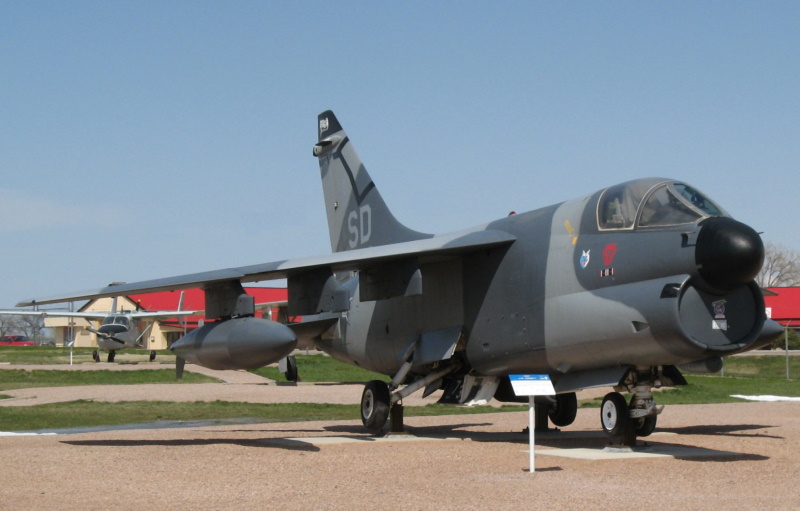
* Sources include:
This document also owes much to a detailed writeup by aircraft enthusiast Joe Baugher.
* Illustrations details:
* Revision history:
v1.0.0 / 01 aug 12 v1.0.1 / 01 jul 14 / Review & polish. v1.0.2 / 01 jun 16 / Review & polish. v1.0.3 / 01 may 18 / Review & polish. v1.0.4 / 01 apr 20 / Review & polish. v1.0.5 / 01 feb 22 / Review & polish. v1.0.6 / 01 jan 24 / Review & polish. (+)BACK_TO_TOP
